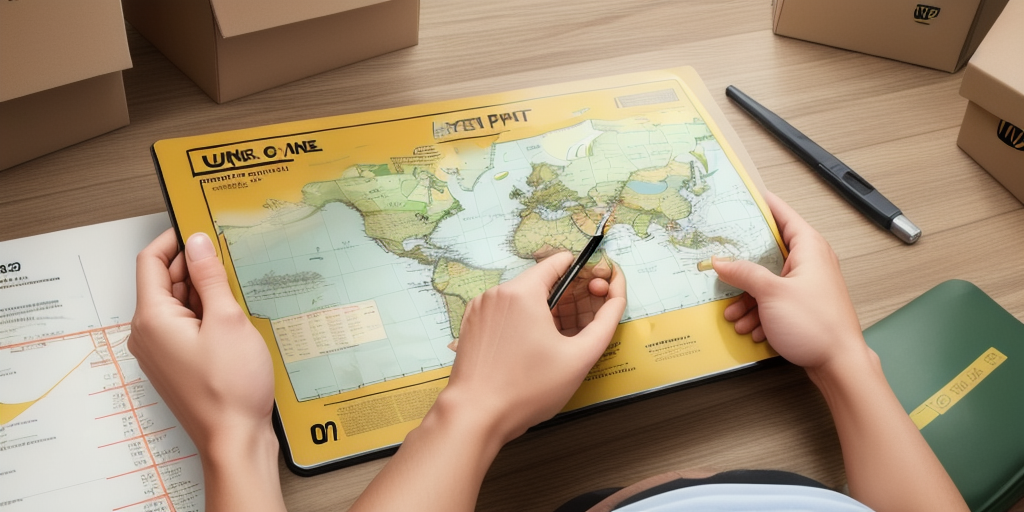Optimizing Your Shipping Strategy with the UPS Ground Zone Map
Efficient shipping is a cornerstone of successful business operations. Ensuring that products reach their destinations safely and promptly, while keeping shipping costs manageable, can significantly impact your bottom line. The UPS Ground Zone Map is a valuable tool that helps businesses and individuals alike calculate shipping costs accurately. In this article, we'll explore how to effectively use the UPS Ground Zone Map and why it's essential for optimizing your shipping strategy.
Understanding the UPS Ground Zone Map
The UPS Ground Zone Map is a comprehensive tool that visualizes the different shipping zones for UPS Ground services across the United States. The United States is divided into seven distinct zones, with Zone 1 representing the closest and most affordable shipping rates, and Zone 7 indicating the farthest and most expensive rates. Each zone is color-coded for easy identification:
- Zone 1: Local deliveries within the same metropolitan area.
- Zone 2: Short-distance shipments to neighboring regions.
- Zone 3: Moderate-distance deliveries covering broader areas.
- Zone 4: Extended-distance shipments reaching across multiple states.
- Zone 5: Long-distance deliveries spanning significant geographic areas.
- Zone 6: Very long-distance shipments often requiring more time and resources.
- Zone 7: The farthest distances, typically involving the most considerable shipping costs.
The primary purpose of the UPS Ground Zone Map is to enable customers to determine shipping costs based on the distance between the shipment's origin and destination, the package's weight, and the selected shipping method. The map is regularly updated to reflect changes in shipping rates and delivery times, ensuring that users have access to the most current information.
The Importance of the UPS Ground Zone Map in Calculating Shipping Costs
Accurately calculating shipping costs is crucial for maintaining profitability and customer satisfaction. The UPS Ground Zone Map offers several benefits:
Accurate Cost Estimation
By identifying the shipping zone, businesses can estimate the cost of shipping packages based on distance. This allows for precise budgeting and pricing strategies.
Comparison Between Carriers
The map facilitates comparisons between UPS Ground rates and those of other carriers like FedEx and USPS. This comparison helps businesses choose the most cost-effective shipping option.
Delivery Time Estimates
The UPS Ground Zone Map provides estimated transit times for each zone, aiding in shipment planning and ensuring timely deliveries.
Strategic Pricing and Shipping Decisions
Understanding shipping zones enables businesses to adjust their pricing or shipping strategies for specific regions, optimizing overall shipping expenses.
Accessing and Utilizing the UPS Ground Zone Map
Accessing the UPS Ground Zone Map is straightforward:
- Visit the official UPS website.
- Navigate to the "Shipping" section and select "Ground Shipping Zones."
- Enter your origin and destination ZIP codes to determine the applicable shipping zone and rates.
Once you've identified the shipping zone, you can use the UPS Ground Zone Map's distance calculator to determine the exact distance between your origin and destination. This information is pivotal in calculating accurate shipping costs.
Determining the Shipping Zone of Your Destination
To determine the shipping zone:
- Enter the origin ZIP code (your location).
- Enter the destination ZIP code (where the package is going).
The map will display the corresponding zone number, color, and shipping rates. Additionally, it may provide information on expected delivery times and any applicable additional fees, such as those for remote or rural areas.
Note: Shipping zones can impact delivery times. Packages shipped to higher-numbered zones may take longer to arrive, so plan accordingly to meet customer expectations.
Calculating Shipping Costs Based on Weight and Distance
Shipping costs are influenced by both the weight of the package and the distance it travels. Here's how to calculate them:
Step 1: Identify the Shipping Zone
Using the UPS Ground Zone Map, determine the shipping zone based on the origin and destination ZIP codes.
Step 2: Determine the Package Weight
Weigh your package accurately to ensure precise cost calculation.
Step 3: Use the Rate Chart
Refer to the UPS Ground rate chart, which outlines shipping costs based on weight and distance (zone). For example:
| Weight | Zone 1 | Zone 4 | Zone 7 |
|---|---|---|---|
| 1-5 lbs | $10.00 | $15.00 | $25.00 |
| 6-10 lbs | $15.00 | $20.00 | $30.00 |
Note: Rates are illustrative. For accurate pricing, refer to the latest UPS rate charts on the official UPS website.
Additionally, consider any extra services such as signature confirmation or insurance, which may incur additional costs.
Leveraging the UPS Online Shipping Calculator Tool
Beyond the Ground Zone Map, the UPS Online Shipping Calculator is a powerful tool for estimating shipping costs. It factors in various elements:
- Package Weight: Accurate measurement ensures precise cost estimation.
- Package Dimensions: Size can affect shipping rates, especially for oversized items.
- Destination: Entering the correct ZIP code ensures accurate zone determination.
- Shipping Method: Choose between UPS Ground, UPS 3 Day Select, UPS 2nd Day Air, etc., based on delivery speed requirements.
Using the calculator allows you to:
- Compare costs across different shipping methods.
- Print shipping labels and schedule pickups.
- Access discounts and special rates for bulk shipments.
Tips to Save Money on Shipping with the UPS Ground Zone Map
Optimizing shipping expenses is achievable by implementing the following strategies:
1. Compare Shipping Rates
Use the UPS Ground Zone Map to compare UPS rates with other carriers like FedEx and USPS. Choose the most cost-effective option that meets your delivery requirements.
2. Utilize Flat Rate Shipping
For small and lightweight packages, UPS offers flat rate shipping options that can be more economical than variable pricing based on weight and distance.
3. Optimize Packaging
Use appropriately sized packaging to avoid unnecessary weight and dimensional surcharges. Efficient packaging can significantly reduce shipping costs.
4. Schedule Shipments in Advance
Planning shipments ahead of time can help you avoid rush shipping fees and take advantage of standard shipping rates.
5. Consolidate Shipments
Combine multiple packages into a single shipment to benefit from bulk shipping discounts and reduce per-package costs.
6. Regularly Review Shipping Strategies
Periodically assess your shipping methods and costs to identify areas for improvement and implement cost-saving measures.
Comparing Shipping Costs Between Different Carriers Using the UPS Ground Zone Map
The UPS Ground Zone Map serves as a benchmark for comparing UPS rates with other shipping carriers:
Steps to Compare:
- Determine the shipping zone using the UPS Ground Zone Map.
- Visit the official websites of other carriers like FedEx and USPS.
- Use their respective shipping calculators to determine rates for the same package specifications.
- Compare the costs, delivery times, and additional services offered by each carrier.
This comparative analysis ensures that you select the most cost-effective and efficient shipping option for your business needs.
Conclusion
The UPS Ground Zone Map is an indispensable tool for businesses and individuals aiming to optimize their shipping strategies. By accurately determining shipping zones, calculating costs based on weight and distance, and leveraging online tools, you can make informed decisions that enhance efficiency and reduce expenses. Additionally, regularly comparing rates across different carriers and implementing cost-saving tips can further streamline your shipping operations.
Remember, while the UPS Ground Zone Map provides valuable insights into shipping costs, it's essential to consider other factors such as delivery speed, package size, and additional services when selecting a shipping method. Staying informed about industry trends and regularly reviewing your shipping strategies will ensure that you continue to receive the best value for your shipping investments.






















